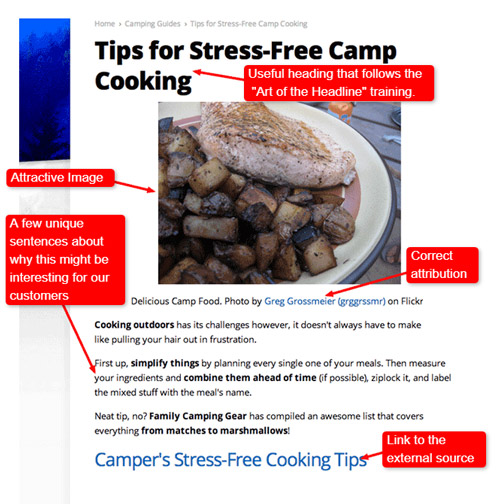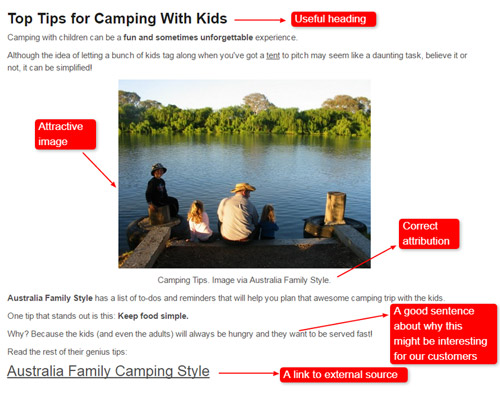
Sometimes there is NOT enough time to create an in-depth, long-format article such as a listicle, how-to article, curated collection or inspiration gallery.
This is where the Short Post format becomes useful. Wonder why?
Creating ‘Short Posts’ is a quick way of creating new content. Search engines like unique, informative content, and you can create it very quickly and inexpensively.
Short posts are quickly published on the blog and conveniently distributed to Social Media channels like Facebook, Google+, Twitter and Pinterest via the Buffer app. They make good fodder for pumping into low-value social media channels.
That’s why you as a future eCommerce copywriter must know how to create it. That’s exactly what you’re going to learn in this lesson.
Ready? Here we go…
What Is a Short Post and How to Create It
A Short Post is typically a few sentences/paragraphs long and includes a few links and images. The aim is to create a quick article that your customers (and search engines) will find reasonably interesting.
Among the easiest ways to do this is to:
- Find interesting things already on the Web
- Summarise
- Point to them
A disadvantage of the short post format is that you are sending customers to another website (usually a blog) and that there isn’t a lot of text on the page. So, use this format sparingly.
Here are a couple of examples that will show you the basics of a really good-quality, quickly written short story that gives credit to other people for their good work.
Don’t hesitate to check out the following examples before we move on.
Example #1

Example #2

So, what conclusions can you draw from these examples? What does a Short Post look like?
As you can see, its essential elements are:
Now, let’s dive a bit deeper into creating such a post, shall we?
Here are the details you should pay attention to.
Short Post Length
- A good short post will be around 60 to 100 words. It will be a summary on the topic – just a few sentences or a few paragraphs that note the essence of the topic.
- Do not copy text from any other website. The content MUST be unique.
What is the ideal length for a social media post? Curious? Go ahead and take a peek at the article to find out.
Next, you could find the article Know Your Limit: The Ideal Length of Every Social Media Post helpful here too because knowing this may increase the possibility that people will read your post and engage with it.
What’s more, a social media character counter is also included in the article. Isn’t this tool super handy?
Then, another expert, Kevan Lee, partnered with SumAll to place all the insights into a fun Infographic: The Optimal Length for Every Social Media Update and More.
Language Use
- Use Australian/British English dictionary for Australian audiences, and American dictionary for non-Australian audiences.
- Understand the target audience. Should you use slang? Should you use abbreviations? Is the style formal or casual?
In short, use the same language your actual audience uses. The article How to Write Better Social Media Posts (And Cut Through The Noise!) offers some tips to help you cop your audience’s word choice.
Here’s what the author Ben Sailer says:
Spend time scanning your follower’s social profiles. Make note of what kinds of things they say, what they talk about, and the language they use to describe anything related to your brand, product, or industry.
Ben Sailer
Read the same websites and publications your audience does. That could include news sites, blogs, and industry publications.
Build a scratch file of commonly used terms and language. This doesn’t have to be super formal, but jotting down commonly used terms and phrases somewhere can be helpful here.
Follow the link and read the full article to find out more. The author also mentions a useful tool – Social Message Optimizer. It would be a good idea to explore it a bit more, don’t you think?
Furthermore, when crafting Short Posts, make sure your language is effective and persuasive enough. More on that topic in our other lesson linked here.
Use Links and Image Use
Use Links
- Include a link to the source website. Give some “link love”.
- Always double-check that the link works before including it to the short post. Don’t send people to dead websites.
Image Use
- Include at least 1 image per short post and/or several other complementary images.
- Look for good images on different websites that offer them. For instance, you can use the search filters to find the most interesting images. In another lesson, you can learn more about how to find highly relevant, top-quality images for your posts using various free and paid image sources.
- Understand Creative Commons license definitions when using Flickr or any other source images. Follow the previous link to our lesson to find out all the reasons and possible consequences if you ignore these licenses.
Done? You see how it can greatly influence your online career and why you should know this all? Excellent!
Still not sure why an image is obligatory?
Take a look at the advice Katie Wolf gives you in her article Writing Short Copy is Hard — Here’s How to Get It Right.
Use design to your advantage!
If you don’t have much space (or many characters) to work with, don’t have to rely solely on text. Incorporating great design can help you get your point across successfully — without adding to the word count.
In a social media ad, a well-selected image that works with your headline can convey the tone and feel of your message, and is likely to be the thing that draws people to your copy (versus the other way around).
A postcard covered in text will probably go straight in the trash — but an engaging image that accompanies a few lines of copy can grab your recipient’s attention and make your message much more effective.
Got it? Sure.
Here’s a bonus for you – 16 Social Media Tools to Help You Write Better Posts. You may also want to read Six Quick Tips for Writing Short Blog Posts for some other helpful hacks.
Great! You know how to create a Short Post. It’s only left to learn how to distribute it via social media channels successfully.
Eager to learn more? That’s the spirit! Just follow the link provided because that topic has been covered in another lesson.
Finished? Nice work!
Since this kind of post is short, the lesson is also concise and to-the-point.
Let’s now put the main learnings in a nutshell before you do the quiz and show that you’ve understood everything.
In Summary
Short posts represent a quick way of creating new content. They can be quickly published and shared on social media.
If you want to create a quick written short story of a good quality then just pay attention to its structure (what you actually have to include in the article). Also, when writing a post, do NOT forget to think about:
- The length of your unique post
- The language that you use (tailor the style to your target audience)
- Using relevant internal and external links
- Using attractive images
You see? It’s pretty simple.
Just be careful NOT to make a mistake of sharing exactly the same piece of content on every single social media network (if that’s your part of work).
Why? Because audience interests, formats and dimensions differ across various platforms as pointed out in the article 11 Social Media Tactics That You Should Test Today.
Now, let’s move on to the quiz to make sure you’ve grasped this knowledge.
